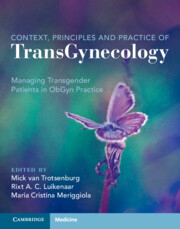Book contents
- Context, Principles, and Practice of Transgynecology
- Context, Principles, and Practice of Transgynecology
- Copyright page
- Dedication
- Contents
- Foreword
- Preface
- Contributors
- Abbreviations
- Section A Contextual Transgynecology
- Section B Practicing Transgynecology
- Section C Gynecological Surgery for Transgender Males
- Chapter 18 Gender-affirming Hysterectomy for Trans Men
- Chapter 19 Opportunistic Salpingectomy in Transgender and Gender Diverse People
- Chapter 20 Colpectomy
- Section D Sexuality and Contraception
- Section E Fertility and Reproduction
- Section F Impact of Gender-affirming Hormonal Therapy on Genital Organs
- Section G Screening and Prophylaxis
- Transgynecology Index
- References
Chapter 19 - Opportunistic Salpingectomy in Transgender and Gender Diverse People
from Section C - Gynecological Surgery for Transgender Males
Published online by Cambridge University Press: 22 December 2022
- Context, Principles, and Practice of Transgynecology
- Context, Principles, and Practice of Transgynecology
- Copyright page
- Dedication
- Contents
- Foreword
- Preface
- Contributors
- Abbreviations
- Section A Contextual Transgynecology
- Section B Practicing Transgynecology
- Section C Gynecological Surgery for Transgender Males
- Chapter 18 Gender-affirming Hysterectomy for Trans Men
- Chapter 19 Opportunistic Salpingectomy in Transgender and Gender Diverse People
- Chapter 20 Colpectomy
- Section D Sexuality and Contraception
- Section E Fertility and Reproduction
- Section F Impact of Gender-affirming Hormonal Therapy on Genital Organs
- Section G Screening and Prophylaxis
- Transgynecology Index
- References
Summary
Despite aggressive treatment, ovarian cancer has a poor prognosis. Therefore, there is an urgent need for primary prevention. Recently, the Fallopian tube has been indicated as organ of origin of most epithelial ovarian cancers. Therefore, an additional (opportunistic) salpingectomy during intraabdominal procedures will lower the burden on epithelial ovarian cancer. The pros and cons of an opportunistic salpingectomy should routinely be discussed also with trans male persons having left the Fallopian tubes in situ and undergoing abdominal surgery for any reason.
- Type
- Chapter
- Information
- Context, Principles and Practice of TransGynecologyManaging Transgender Patients in ObGyn Practice, pp. 145 - 147Publisher: Cambridge University PressPrint publication year: 2022



